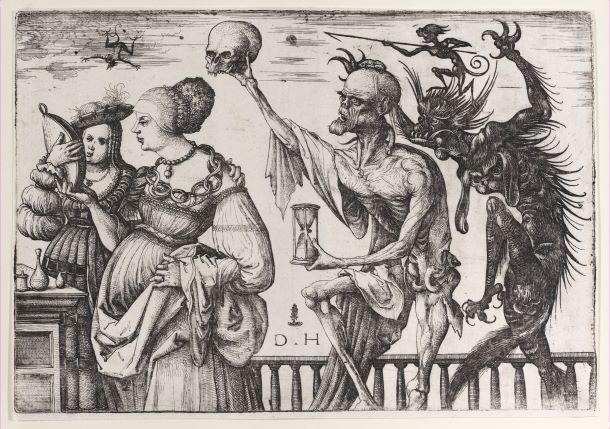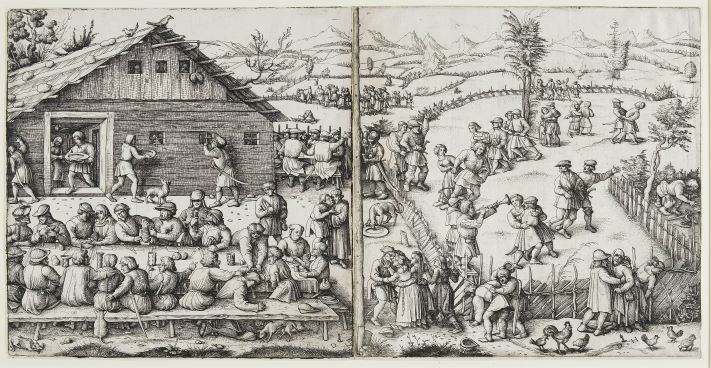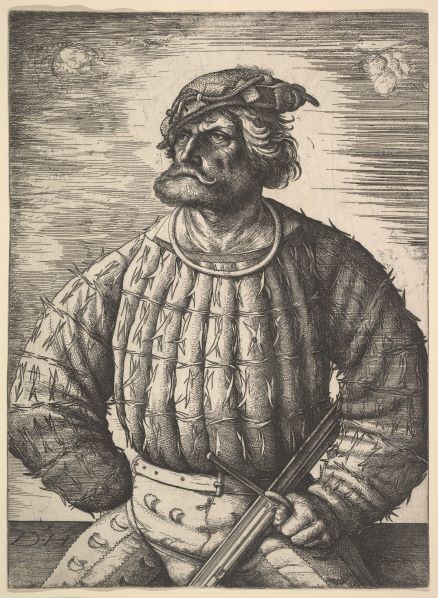What is the etching printmaking process and how did it come to be?
Find out more about the process through which an armorer from the middle ages established the etching printmaking technique.

Etching is still one of the most popular ways to make an intaglio print. On the one hand, it involves a fairly complicated chemical process. For example, instead of engraving the cliché or cutting the fibers by hand, the most labor-intensive steps are done by an etcher. On the other hand, the artist can be spontaneous with the line of the drawing and use multiple etchings to create a composition with different levels.
A polished metal plate, most often copper or zinc, is coated with a protective varnish. After the varnish has dried, the drawing is scratched into it with a special tool - a needle embedded in a feather. The plate is then subjected to controlled corrosion by placing it in an etchant for some time.
This produces a negative relief on the plate. Once the etching process is complete, the protective varnish is washed off the plate with solvent, the ink is worked into the surface of the plate and the ink is pressed from the lines into the wetted paper using an etching press under high pressure.
Etching was first done by an Augsburg craftsman named Daniel Hopfer at the turn of the 15th and 16th centuries. However, people had been etching different materials for hundreds of years before that.
The evolutionary paths of etching
In the Indus Valley civilization, ornaments on stones were etched with alkali. This etching did not create relief, but the effect was to change the tonality of the surface, similar to henna drawings on the skin. In China in the 5th century BC, the etching of ornamental designs on bronze mirrors, spearheads, and sword blades was typical.
In North America, the Hohokam tribe near the Gulf of California practiced ornamental etching on shells from the 4th century BC until the arrival of European settlers. These examples show a series of events that don't go together. Also, these individual artifacts don't tell us anything about how this kind of technology works.
If we want to understand the origins of metal etching, we need to look at the ancient tradition of making weapons. The Celtic weapons of the La Tene culture found in the Neuchâtel area of Switzerland date back to the 1st century BC. They are not only well-crafted iron weapons but also outstanding examples of applied art. They are embedded with geometric patterns, similar to those of Chinese craftsmen, using metal etching.
The eminent historian of the ancient world, Diodorus of Sicily, in his Library of History (60-30 BC), describes the technology of Iberian Celtic sword making. According to his account, the Celts buried iron plates in acidic soil for a certain period, allowing the surface to become coated with a layer of rust, after which it was mechanically scraped off. This treatment made the iron many times stronger.
King Trazamund of the Vandals once sent two magnificent swords to King Theodoric of Ostgoth, whose secretary Cassiodorus, in a letter of thanks to Trazamund, emphasized the extraordinary qualities of the swords - the lines embedded in the blades and their brilliant luster.

Metal can be polished to a shine in a weak acid environment. Celtic craftsmen probably used vinegar, a foodstuff that was also used in various craft practices in later centuries. Micro-etching can change the surface texture and tonal shade of the material, but it is not possible to etch a sophisticated relief pattern.
Translations of 12th-century Arabic scholars' research, combined with the inheritance of Celtic blacksmithing traditions, provide the basis for the skills of medieval European craftsmen. Two methods of pickling metals are developed: copper sulfate solution and nitric acid.
One of these methods, the retention of iron in a copper sulfate solution, is associated with the method of gilding swords. In this procedure, copper ions bind to the surface of the iron and form a layer of copper which serves as a base for the gold.
The earliest known description of this technology is from the 8th century. The earliest attestation of this goldsmith's knowledge is found in the manuscripts of the city of Lucca. It is stated that lye, alum, and common salt are mixed in equal parts, the mixture is dissolved in water and the natural resin tragacanth is used as a protective layer to form the stencil.
In addition to etching with copper sulfate solution, around the 13th century, water was used as a base for the glaze. In the 13th century, etching with nitric acid became known in Europe. The availability of this method is due to the development of military technology.
In particular, one of the components of nitric acid, saltpeter, or potassium nitrate, is a basic component of gunpowder. It is precisely with the increasing importance of gunpowder on the battlefield that the mass production of saltpeter is developing and with it the possibility of distilling nitric acid in such quantities as to make it available to craftsmen of all trades.

The secrets of nitric acid distillation can be found in the laboratories of medieval alchemists. One of the most cited sources is Pseudo-Geber and his 13th-century manuscripts Summa perfectionis magisterii and De inventione veritatis. It has been suggested that Paolo di Taranto of Apulia may have been the true author of these treatises, but the works have been attributed to Jabir ibn Hayyan, the 8th-century alchemical progenitor of Baghdad.
The Pseudo-Geber's text describes the distillation of aqua-forte, 'strong water' or nitric acid, by taking one pound of vitriol, half a pound of saltpeter, and a quarter of a pound of alum. At the end of the 13th century, Albert the Great, a theologian and doctor of sciences from Cologne, and Raymund Llull, a mystic and philosopher from Catalonia, both wrote about the distillation process of aqua forte.
Research into the distillation of 'strong water', attributed to the Franciscan bishop Vital du Four, who lived in France at the turn of the 13th and 14th centuries, reveals the following recipe: one pound of saltpeter and one pound of vitriol, mixed with alcohol and distilled twice with good wine. The distillate dyes the wool yellow and can dissolve any metal.
Vital du Four also describes practical techniques for pickling metals. The following formula is used: hazelnut charcoal is mixed with copper acetate and dissolved in urine or vinegar. The object to be etched is dipped in melted wax and the letters or drawing are embedded in this layer. The object thus prepared is immersed in the mordant for several days until the desired result is obtained.
Manuscripts from the 15th century reveal at least ten different methods of pickling metals. Most commonly, an iron plate is coated with wax, oil varnish, or oil paint, and the image is scratched into it and then etched.
Another method involves mixing an etching agent with powdered charcoal and applying the etching mixture to the plate. It is also possible to apply the image to the surface with oil paint, then etch the areas surrounding the drawing. Another method instructs the pouring of caustic salts into a vinegar-moistened cloth bag, then placing it on the parts of the plate to be etched.

Daniel Hopfer and the invention of etching printing
All these craftsmanship skills of alchemists and artisans have been refined over the centuries and have triumphed in the artistic treatment of metal armor. One such master craftsman is Daniel Hopfer (1470-1536). Born in the small Swabian town of Kaufbeuren, he made his fortune as a master armorer of horses and cavalry in Augsburg, one of the arms manufacturing centers of the time.
Hopfer's invention is the combination of two traditional crafts in one - namely copper engraving and iron armor pattern etching in a new printing technique - etching. It should be noted that the name of the technique has different traditions in different languages: one expresses the way of working the metal - sharpening (English: etching and German: radierung), while the other expresses the etcher, i.e. "strong water", which is also taken from the Romanic languages (Italian: aqua-forte and French: eau-fort).
Hopfer made his first etching plates around 1500. The well-to-do member of the Augsburg blacksmiths' guild was able to produce around 230 original works or etchings or copies of works by notable artists during his lifetime. Hopfer also entrusted his invention to Albrecht Dürer. The famous Nuremberg painter and printmaker produced his first etchings in 1515, but the new medium did not inspire lasting interest in the master and Dürer remained faithful to copper engraving.
But in 1521, he was visited by the Dutch painter and virtuoso engraver Lucas van Leyden, who enthusiastically embraced etching technology and took it with him to Holland. It would be another century before another son of the city of Leiden fully appreciated the artistic freedom of etching. The name of this often misunderstood, but extraordinarily thinking and feeling artist is Rembrandt van Rijn.
It was Rembrandt van Rijn who began the triumphal march of the etching technique. And European artistic expression in this century is also increasingly freeing itself from the canonized medieval rigidity, as opposed to the Golden Age of Dutch art in the 17th century. The etching expression is the antithesis of the canonized tradition of line engraving. The etching needle glides over the metal plate without the slightest resistance and the printmaker who uses this technique can experience absolute artistic freedom.




